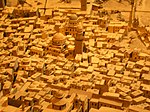Tiferet Yisrael Synagogue

Tiferet Yisrael Synagogue (Hebrew: בית הכנסת תפארת ישראל; Ashkenazi Hebrew: Tiferes Yisroel), most often spelled Tiferet Israel, also known as the Nisan Bak Shul (Yiddish: ניסן ב"ק שול), after its co-founder, Nisan Bak was a prominent synagogue between 1872 and 1948 in the Jewish Quarter of the Old City of Jerusalem. The synagogue was inaugurated in 1872 by the Ruzhin Hasidim among the members of the Old Yishuv and was destroyed by the Jordanian Arab Legion on 21 May 1948 during the Battle for Jerusalem of the 1948 Arab–Israeli War.The synagogue was left as ruins after the recapture of the Old City in the Six-Day War. In November 2012 the Jerusalem municipality announced its approval for plans to rebuild the synagogue. The cornerstone was laid on May 27, 2014.
Excerpt from the Wikipedia article Tiferet Yisrael Synagogue (License: CC BY-SA 3.0, Authors, Images).Tiferet Yisrael Synagogue
Heil HaHandasa, Jerusalem Morasha
Geographical coordinates (GPS) Address Nearby Places Show on map
Geographical coordinates (GPS)
| Latitude | Longitude |
|---|---|
| N 31.775369 ° | E 35.232339 ° |
Address
העיר העתיקה בירושלים וחומותיה
Heil HaHandasa
9511208 Jerusalem, Morasha
Jerusalem District, Israel
Open on Google Maps







